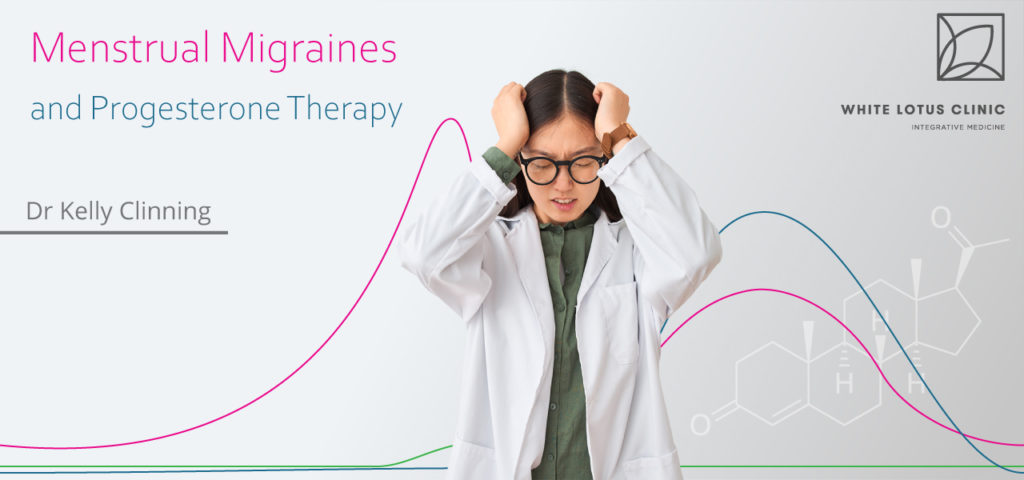In a hurry? Click here to read the key takeaways, otherwise let’s start by understanding what menstrual migraines are and what causes them…
Migraine types and the Menstrual Migraine
Migraines can be triggered by dietary and lifestyle factors, including certain foods, alcohol, stress and blood sugar imbalance. Once triggers are identified and modified, many migraines can be significantly improved. However, there is one type of migraine that I have come across frequently in practice that’s much more difficult to get rid of. This is known as a menstrual migraine. It’s a migraine that is typically experienced in the 2-3 days before the menstrual period starts, or during the first few days of bleeding1.
So what causes menstrual migraines?
Menstrual migraines are caused by a change in levels in either of the two main female sex hormones: estrogen and progesterone. In the days before the menstrual period starts, both estrogen and progesterone levels drop. This sudden hormonal plummet can trigger a menstrual migraine. Both estrogen and progesterone can cross the blood-brain barrier and impact the brain’s nervous system and pain processing networks1. Estrogen also has effects on the serotonergic system. In fact, relationships between estrogen and brain neurotransmitters such as norepinephrine, dopamine, and endorphins have been found1. Research suggests that it’s most likely the drop in estrogen that triggers menstrual migraines, based on these interesting associations2.

Interestingly, some women experience hormonal migraines at other points throughout their cycle. For example, sometime around ovulation—when estrogen levels peak and then fall—is time when a hormone-related migraine can manifest.
Incidence of hormonal migraines can also increase during perimenopause, when estrogen levels fluctuate rapidly. This also reinforces the idea that changes in estrogen levels are the likely cause3.
How progesterone can help menstrual migraines
Bio-identical progesterone can be very helpful for treating menstrual migraines. Progesterone is an anti-inflammatory hormone that calms the nervous system and is estrogen’s natural opposite3. In fact, taking progesterone for several days before the menstrual period starts can help soften the drop in estrogen and progesterone, and therefore improve the migraine’s severity.
Progesterone can be administered in three forms: orally, topically, and as a suppository. Dr. Jerilynn Prior, who has done years of research on the importance of progesterone in female health, discusses the other benefits of progesterone in her article here.
Oral progesterone may be best for women who also experience sleep issues. This is because it’s converted into a neurosteroid called allopregnanolone, which can improve sleep. In contrast, the suppository form may be more indicated if you experience heavy and painful periods.
Progesterone can also be very helpful for women going through perimenopause, experiencing symptoms such as mood swings, hot flashes, and heavy bleeding.
Other treatment options
Progesterone isn’t the only therapy for migraines. In fact, many additional natural alternatives have been researched and found to be effective for migraine relief. Some of these treatment options include:
Magnesium: evidence suggests that magnesium plays an important role in migraine pathogenesis4. Magnesium deficiency can impact serotonin receptor function and the production and release of several neurotransmitters4 . There is strong evidence that those who suffer from migraines are more likely to have a magnesium deficiency 4.
CoQ10: CoQ10 is an antioxidant that the body produces which is essential to energy production. This study found that CoQ10 significantly reduced both the frequency and severity of migraine attacks without adverse effects5.
Ginger: Ginger is an anti-inflammatory herb that has been found to be comparable in effect as a common migraine medication, sumatriptan, in stopping migraines, and with fewer adverse effects6
Key Takeaways from this article
- Menstrual migraines are common in women, and occur in the 2-3 days before the period starts and/or the first few bleeding days
- These migraines are caused by the drop of hormones (progesterone and estrogen) that occurs before the period starts
- Progesterone therapy is an effective treatment option for menstrual migraines since it acts as an anti-inflammatory and is calming to the nervous system
- This therapy may also be effective for other symptoms experienced in the pre-menstrual period including: sleep disturbances, anxiety, and heavy periods
The first step is to determine if your migraines are related to your menstrual cycle. Track your migraines in relation to your cycle using one of the phone apps available, such as Clue or Kindara. Bring this information to your doctor to discuss what types of patterns your migraines are following, as well as potential treatment options!
References
- Sacco, S., Ricci, S., Degan, D. and Carolei, A. (2012). Migraine in women: the role of hormones and their impact on vascular diseases. The Journal of Headache and Pain, [online] 13(3), pp.177-189. Available at: https://www.ncbi.nlm.nih.gov/pmc/articles/PMC3311830/.
- Martin, V. and Lipton, R. (2008). Epidemiology and Biology of Menstrual Migraine. Headache: The Journal of Head and Face Pain, [online] 48, pp.S124-S130. Available at: https://www.ncbi.nlm.nih.gov/pubmed/19076658.
- Prior, J. (2015). Perimenopause and menopause as oestrogen deficiency while ignoring progesterone. Nature Reviews Disease Primers, [online] 1(1). Available at: https://www.ncbi.nlm.nih.gov/pmc/articles/PMC3987489/.
- Mauskop, A. and Varughese, J. (2012). Why all migraine patients should be treated with magnesium. Journal of Neural Transmission, [online] 119(5), pp.575-579. Available at: https://www.ncbi.nlm.nih.gov/pubmed/22426836.
- Shoeibi, A., Olfati, N., Soltani Sabi, M., Salehi, M., Mali, S. and Akbari Oryani, M. (2016). Effectiveness of coenzyme Q10 in prophylactic treatment of migraine headache: an open-label, add-on, controlled trial. Acta Neurologica Belgica, [online] 117(1), pp.103-109. Available at: https://www.ncbi.nlm.nih.gov/pubmed/27670440.
- Maghbooli, M., Golipour, F., Moghimi Esfandabadi, A. and Yousefi, M. (2013). Comparison Between the Efficacy of Ginger and Sumatriptan in the Ablative Treatment of the Common Migraine. Phytotherapy Research, [online] 28(3), pp.412-415. Available at: https://www.ncbi.nlm.nih.gov/pubmed/23657930.





